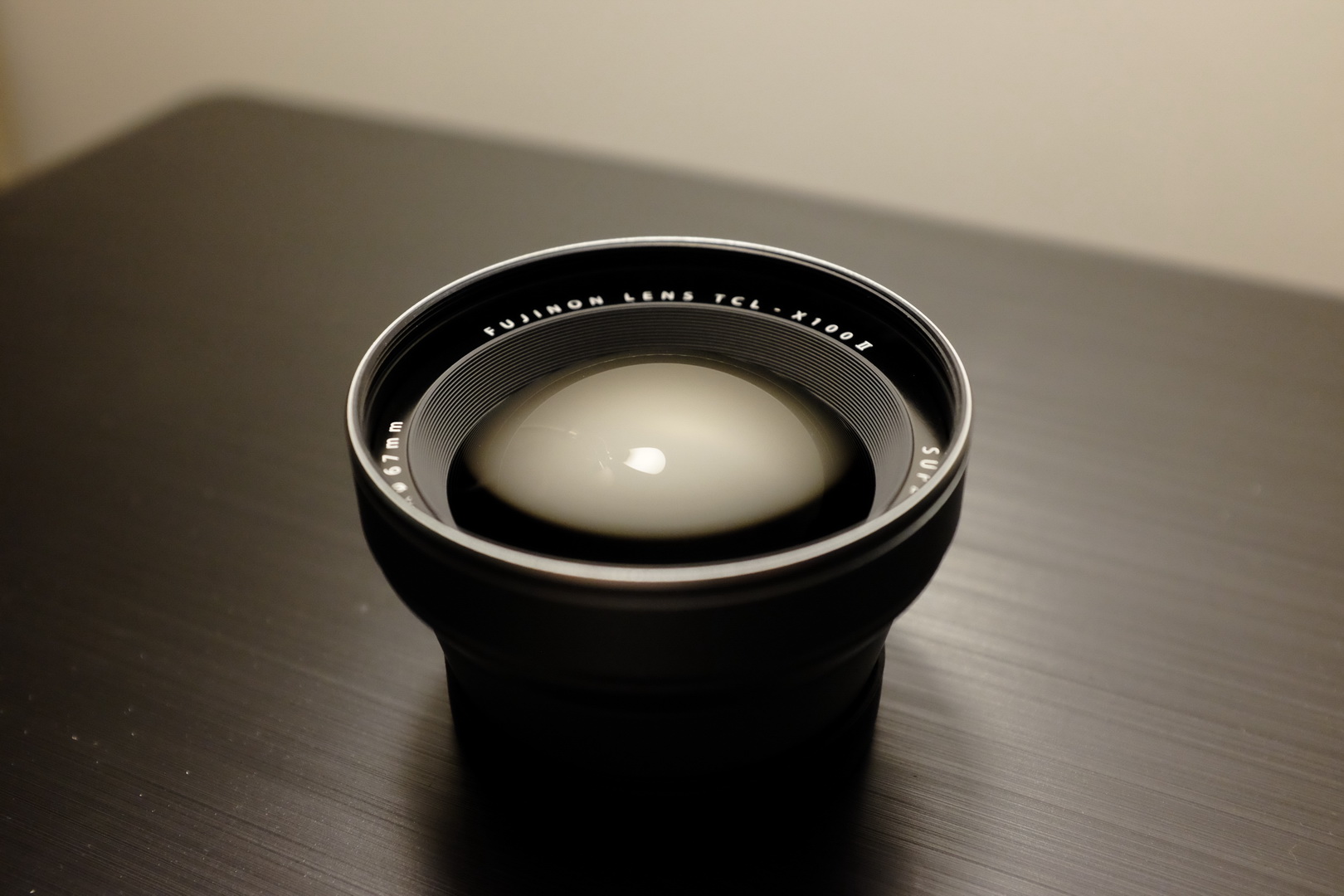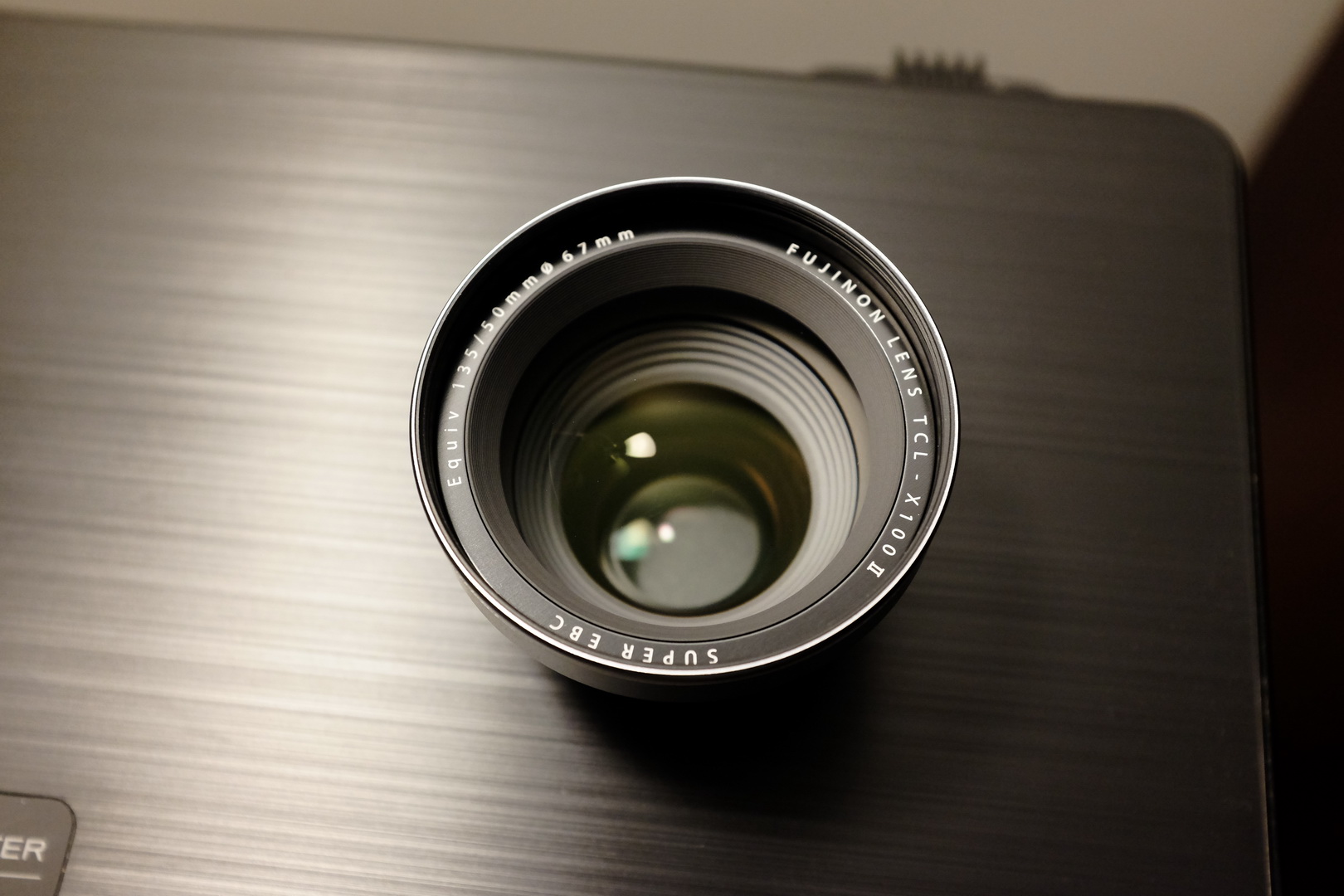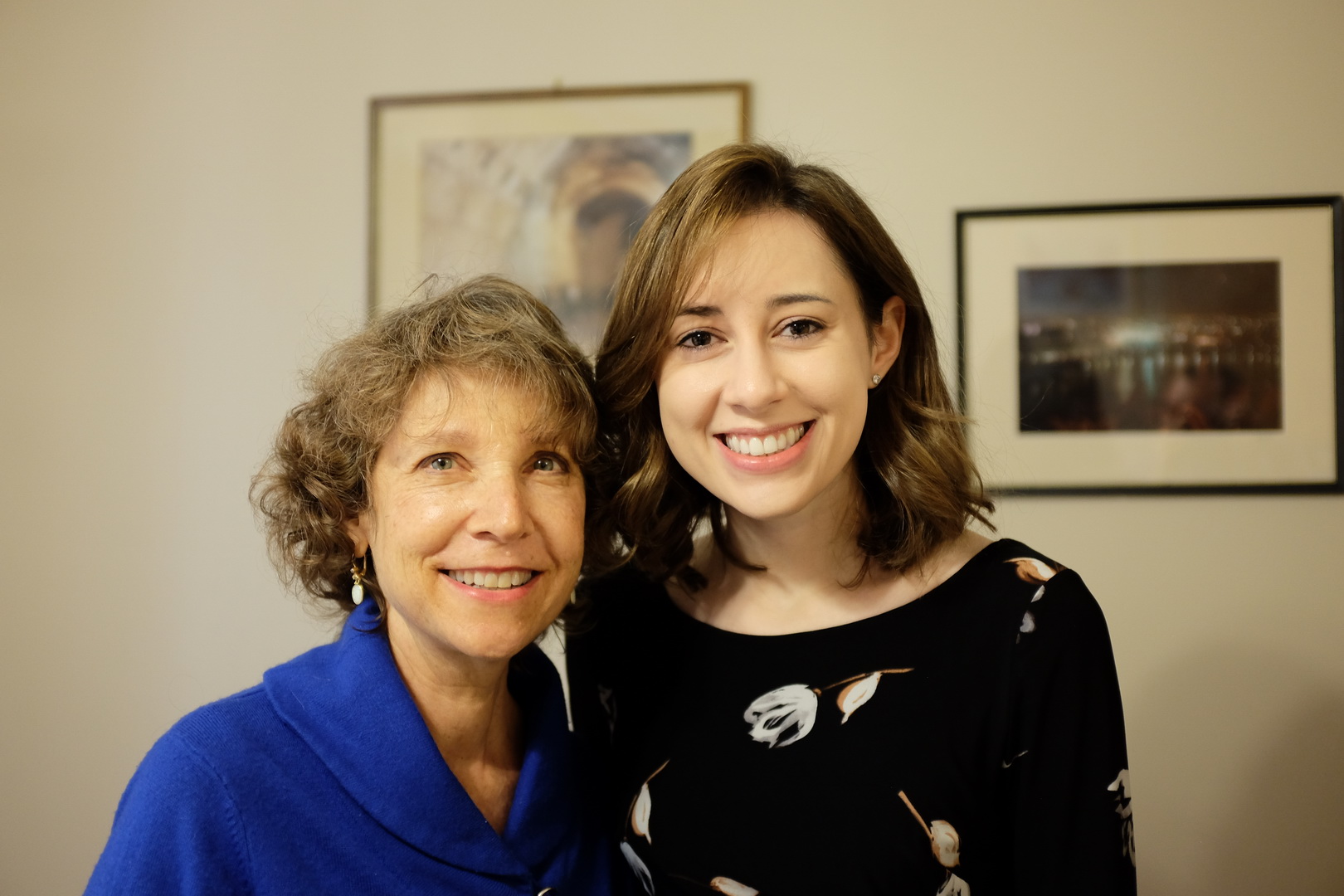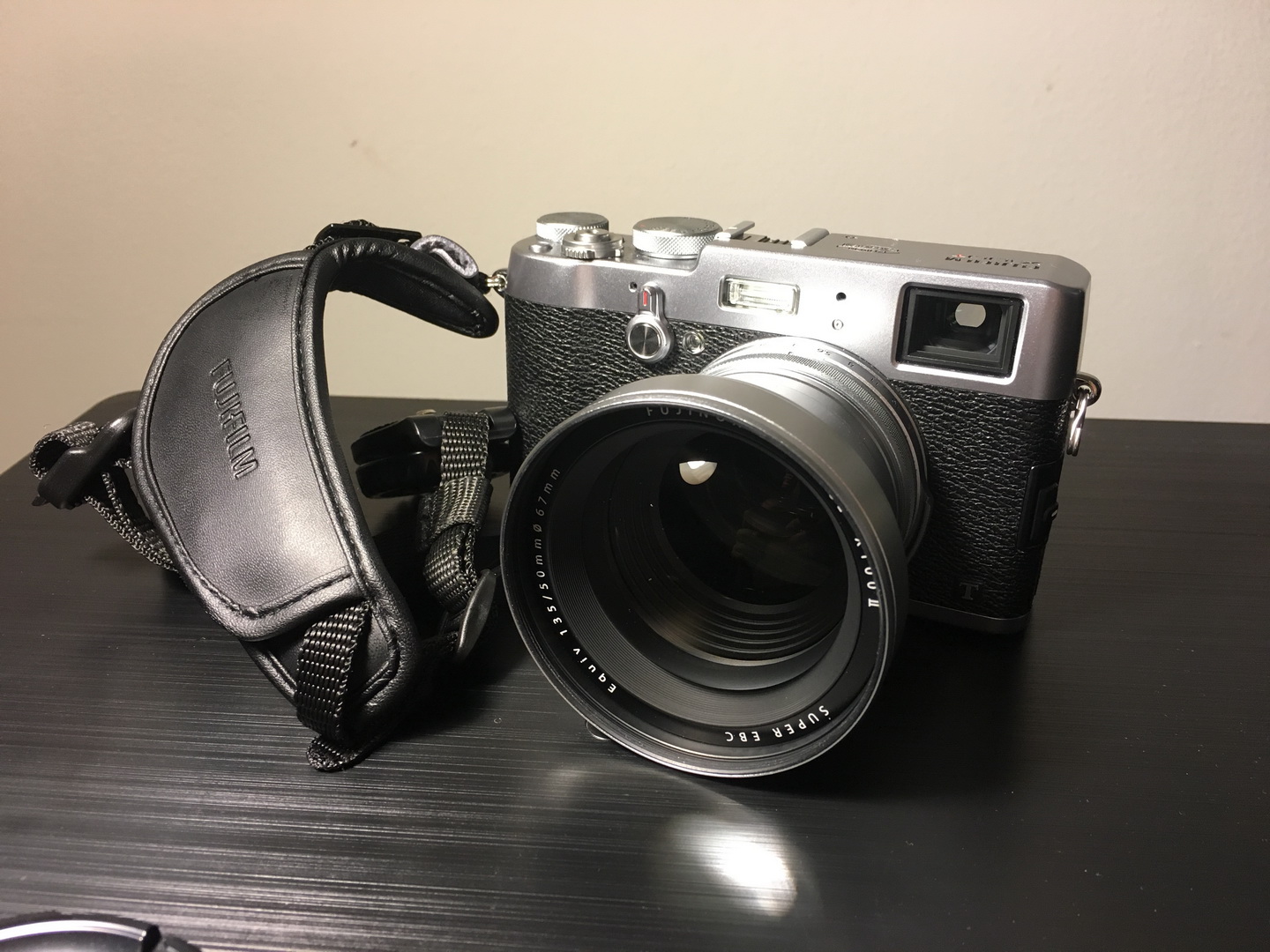In addition to
my aforementioned impulsive purchase of the Fujifilm Instax SP-2 smartphone printer
(for printing mementos from social occasions), I also impulsively purchased the
Fujifilm TCL-X100 II
teleconversion lens for my
Fujifilm X100T camera.
This was something I was thinking about for a while about a week, and
although I hesitated quite a bit in the store, I ended up pulling the trigger on it.

The Fuji TCL-X100 II conveter lens is an engineering marvel, and when attached to the camera, looks quite convincingly part of the original body. It’s quite attractive.
The Rationale
The X100 camera series is an incredibly fun and capable line of cameras with a
well-deserved reputation for dynamic fixed focal-length shooting. The 35mm
equivalent focal length performs serviceably at both portrait and landscape work,
and excels particularly with street and social photography, which often blend
elements of the two. The main reason to buy into this camera series instead of
something like the X-Pro series, which also has an optical viewfinder, is
(aside from price) the compact size and robust fill flash experience achieved
with such a small package.
That being said, for someone with only a single camera (like me), there are times
when a 35mm focal length leaves a little something to be desired. Sure, if I’m
going on a mountain hike, I might want a wider perspective than a 35mm equivalent
can manager; and if taking portraits, a tighter perspective draws the eye in a
more flattering manner. To this end, Fujifilm offers a pair of teleconverters for
the X100 camera series, which can step down or up the base lens to 28mm or 50mm
equivalents, respectively.

The lens is offered in both silver and black accent colors, matching the silver and black camera body options.
I don’t go on hikes often and don’t generally find myself wanting a 28mm lens
so often (aside from how all smartphone cameras are 28mm equivalent themselves).
However, I do often want to get tighter portraits in social settings. Could a
converter offer enough to avoid me needing to purchase a whole new interchangeable
lens system?
As Thanksgiving weekend was about to spring upon me, I took the plunge and bought
the lens from B&H on the faith that I’d like it and relying on their return
policy in case it didn’t work out for me.
The lens performs (almost) exactly as advertised! The bokeh is deliciously creamy
and chromatic aberrations are minimal and not generally noticeable in typical
shooting. Obviously, handholding a 50mm equivalent is somewhat harder than
handholding a 35mm equivalent, but that’s part of what I signed up for.

My beautiful wife and aunt. At f/2 and 1/60s, the image can get soft or even softer than with the base lens. However, the distinctive perspective and creamy bokeh offer a compelling argument to use this converter.
Though neither hidden nor advertised, the widest apertures of the X100 series'
23mm f/2 lens have a reputation for getting soft/hazy looking when open all the
way to f/2. With the portrait lens converter, this is at best the same, if not
slightly worse; f/4 is mostly fine, but f/2.8 and f/2 seems (if anything) a drop
less sharp than even the base lens at those apertures. This puts the converter
in an interesting position – it’s definitely not as sharp as a dedicated standalone
lens of an appropriate caliber would be, but for something like f/4 or f/2.8
the value of this converter seems arguably reasonable.
The Caveats
There are a few caveats of using this lens on paper:
- As noted above, the converters build upon the base lens system, and the base
lens system isn’t as robust at wide open apertures as a dedicated prime lens.
The dedicated primes cost a decent bit more than the converters do, but if
using them to the fullest is of concern, the converter may not be an
appropriate compromise.
- This teleconverter, as shown above, has a chunky profile, which is how it
houses the glass needed to preserve the light-sensitivity of the base lens
system without vignetting. (It’s also an engineering marvel!) That being said,
it does obstruct the flash, making the flash harder to use.
- This converter’s heft also obstructs the optical viewfinder, as the large
profile blocks the five o’clock part of the frame.
- This is probably minor, but cameras before the X100F, like mine, a software
setting must be toggled to change the software profile used for the in-camera
distortion correction.
The Experience
Given the caveats mentioned above, I naively thought the experience of shooting
would not be much impacted. How naive I was! In practice
the experience can often be dramatically compromised when using this converter,
and this happens in a very subtle but tangible way. The transcendence of the X100
series emerges not just from its fast, sharp lens, or its tactile analog exposure
dials, but from the fun and flexibility of the optical viewfinder in tandem with
the compact camera system and its dazzling fill flash.
Although not apparent in the spec sheet, the compromises to the optical viewfinder
and the cutting off at the knees of the on-board flash by the 50mm equivalent
converter dramatically undercuts the usefulness of the system as a whole relative
to the base system. Ironically, the teleconverter presents a choice between a
respectable perspective-portrait camera and a dynamic all-in-one dynamo.
For street shooting, the rangefinder style optical viewfinder presents a
refreshingly contemplative composing experience when compared with both SLR
viewfinders and with the live-preview in the electronic viewfinder. The promise
that an SLR camera offers is of living in the moment, seeing nothing more or less
than the final result of the picture. Comparatively speaking, the rangefinder
grasps at omniscience, seeing beyond the immediate frame to offer expansive
timing and compositional insights. It’s a fleeting experience that few modern
photographers have had the joy of experiencing, but there’s a strong argument
that an rangefinder offers superior composition capabilities than either an
electronic viewfinder or a single-lens reflex system.
With the teleconverter attached, though, the lens ends up approaching an 85mm
in size and heft, thoroughly obstructing a significant portion of the bottom
right-hand corner of the frame, as well as the area beyond the frame. It functions
to blind the photographer to their right side, compared with the base lens which
permits the photographer to see moving people or objects entering the frame.
The result is wonky; the right half of the frame feels like looking through an
SLR, but the left of the frame retains its expansive perspective. Mixing the
breadth of the rangefinder to port and the SLR to starboard results in an awkward,
half-unsure experience.
Although a bulky converter sitting between photographer and subject doesn’t
in any way impact the stellar electronic viewfinder, one doesn’t simply buy the
X100 series for the electronic viewfinder and ignore the optical viewfinder.
Whereas the obstruction of the optical viewfinder is a matter of perspective,
the blinding (or should I say binding?) of half of the flash is a highly
practical concern. I cannot enumerate just how many times my shots have been
won or lost at the hands of the X100 camera flash. From filling outdoor portraits
in the mid-afternoon sun to recovering vignettes from faintly lit wedding dances,
this flash is in many ways the cherry on top of an already exceptional camera.
Thus, exposing a floating shadow to the bottom of my photos while illuminating
the tops confuses both me and the camera. I can, of course, use the camera with
the converter and without making use of the built-in flash, but that diminishes
the versatility of the camera. I could try getting a hotshoe flash, but at that
point, I really have an underweight and underpowered interchangeable lens camera.

The Fuji X100 with the TCL is a funny animal. Until f/4 it’s fine. Beyond that aperture, tradeoffs come fast and frequently. Abandon the on-board flash, or buy an external one? Abandon the optical view-finder, or struggle on with it?
What to do?
I’m still vacillating about whether to keep this camera, even after getting
my primary shots out of it. The lens does what is advertised; but at some cost.
The base camera system is greater than the sum of its parts, but the camera with
the converter is “merely” the sum of its parts (including the converter).
As an addition to the camera system, it’s a worthy addition in an absolute sense;
but in terms of camera delivered per dollar spent, the
converter actually diminishes from the superb value of the base system.
The way I’m thinking about this at the moment is as follows:
Given that I have a standalone camera with which I’m happy, I don’t see the
need to buy another camera/body. However, sometimes I would like to take
portraits. As long as I’m okay with my portrait ability being less than with
a dedicated interchangeable-lens camera, in exchange for a slightly lower price,
this setup makes sense. Otherwise, it makes more sense to either not hold onto
the converter, or even just dump the entire X100 series for an interchangeable
lens series.
Based on this rationale, which is a subtle refinement of my original rationale,
it still makes sense to hold onto this converter. That being said, I definitely
don’t think it’s a must-buy or an amazing value, simply because it detracts so
much from spirit and camera/dollar ratio of the base system. I still have two
weeks to change my mind, but I think I’m going to hold onto this, since I’m so
enamored of candid portrait photography.